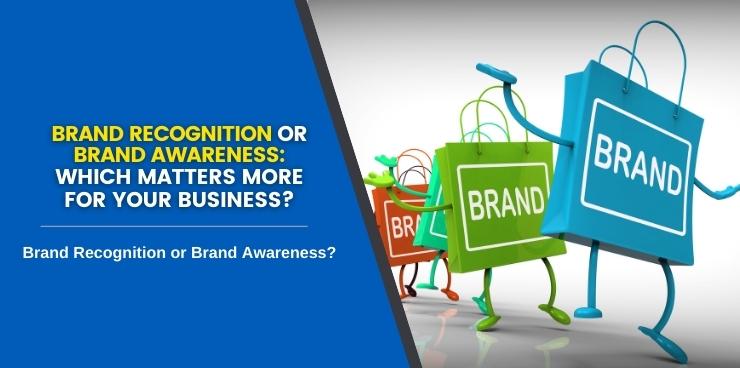Brand awareness and brand recognition are two vital pillars in acquiring a steady stream of loyal customers. Without a memorable and remarkable brand, you sacrifice visibility which often translates into lower sales and profits.
Ask any entrepreneur what they fear most in their business and they’ll focus on tangible aspects like declining revenue. What they don’t realize is that their bottom line is greatly dependent on how good their brand awareness strategies are.
The most critical pitfall of a business is obscurity.
When your business becomes just another service provider, your profitability suffers. To this end, you need solid brand recognition and brand awareness to help you stand 600 ft. above your competitors. Every business owner wants to be the top company in their market’s mind and decision-making.
If you were forced to choose, which concept would you opt to focus on?
Should you strengthen your brand awareness strategies or should you stick with building good brand recognition?
Here, we’ll differentiate brand recognition and brand awareness, explore their respective impacts and discover how you can measure them. Keep reading.
Brand Awareness and Brand Recognition Are Not the Same
Though often used interchangeably, brand awareness and brand recognition are very distinct ideas that focus on different things.
Before delving into their differences, it’s important to first fully grasp the term by which both concepts are anchored– brand.
A brand is the sum total of what makes your business unique. It’s the combination of your goods and services that distinguishes your business from other solution providers. Branding, on the other hand, are the actions taken to create a memorable identity that elicits a positive business perception. This covers elements that remain uniform throughout your messaging like your logo, design, brandable chunks, buying experience, and culture, to name a few.
Brand recognition then is a state where customers can identify a business based on its features and characteristics. This could range from identifying a company based on a logo to accurately describing a business’s list of solutions. The former is easier to achieve but the latter indicates better brand recall which leads to brand loyalty and preference.
Conversely, brand awareness is a top-of-mind awareness. This is when consumers are familiar with a business but can’t necessarily articulate what the essence of the brand stands for. Think of it this way, it’s the first thing that comes to mind when you hear a product or industry.
Both brand awareness and brand recognition play significant roles in the success of a business. This is especially important for competitive and saturated markets like the residential home service industry.
You need to develop both concepts in your arsenal to secure your competitive edge in the market. Otherwise, you become just another business in a Sea of Sameness, and you don’t want that.
Refining your brand awareness and brand recognition is the only way to break through and dominate the competitive landscape. If that’s what you want, Wizard of Sales® is the brand strategist you need. Book a call.
Brand Recognition vs Brand Awareness
Brand recognition and brand awareness are two coveted qualities that small and medium-sized businesses desire from household brands. The problem is that businesses don’t always possess both brand recognition and awareness among consumers. More often than not, prospects have no idea your company even exists.
Imagine the popular painting service provider, Wow! 1 Day Painting.
People who are merely aware of the brand may identify the company only at face value. “Oh yeah, they’re the painter guys with the green trucks” or ,”I hear they can paint a house in 1 day“. The level of awareness is limited to what you’ve seen or heard from other people. You may have some awareness of them, but you don’t truly recognize the entirety of their value proposition.
In this example, the level of brand awareness just isn’t high enough to result in brand loyalty or customer acquisition.
On the other hand, brand recognition enables people to eliminate the smoke screen and understand businesses at a deeper level.
Going back to the example, brand recognition would allow customers to know that they offer more than painting services. Wow 1 Day Painting has ancillary services like popcorn ceiling removal, wallpaper removal and drywall repair. Furthermore, the secret behind their painting efficiency is a painting technique and system they’ve implemented and perfected for 20 years.
So, which matters more for businesses?
While ideally having both is important, brand recognition is often viewed as more valuable than brand awareness. Having recognition increases the likelihood of building brand loyalty and brand recall or the tendency to remember a business.
Moreover, with remarkable brand recognition, there is a higher chance that your values resonate with your customers. Your business becomes more than your logo and tagline but embodies a set of core values that customers care about. To that end, customers feel confident and assured that your business speaks and understands their personal values.
What Are The Impacts On Home Services Business Owners?
Definition and importance are not the only aspects where brand awareness and brand recognition differ. How both of them impact home service businesses and business owners also varies. Knowing how each can affect your business allows you to shift your marketing efforts.
Brand awareness speaks more to potential customers who may not have heard of your business before. Investing in brand awareness will increase the number of people who are exposed to your brand.
On the other hand, brand recognition is better suited for businesses that have already established themselves in the market. This way, you can focus on solidifying your reputation and getting customers to recall your brand name beyond your logo and truck wrap.
Here are the impacts of brand awareness and brand recognition on home service businesses and entrepreneurs.
Impact of Brand Recognition
Brand recognition surpasses all other elements in importance when it comes to branding. Recognition is more than your logo, slogan, or identifying colors. It’s the bridge that emotionally connects your business and what it stands for to your targetted consumers.
Do you ever get a mental image or relive a personal experience whenever you see or hear a brand’s name?
For example, when you see the Nike swoosh, do you think about hauling your a*s off the couch and doing something? When you see McDonald’s golden arches, does your mouth water for a McRoyale with Cheese?
These are all examples of brand recognition at work.
A solid brand recognition transcends the physical and connects with customers on an emotional level. Consider Morris-Jenkins’s most popular commercials: the “Mr. Jenkins and Bobby” campaign. Mr. Jenkins portrayed his role as a specialist while Bobby represented an enthusiastic tech patiently waiting for a call each evening.
Their innocent yet information-dense banters helped position Morris-Jenkins as the experts and caring HVAC service providers everyone in Charlotte loves today. They built a reputation for accomplishing tasks from an expert viewpoint while leaving a positive and memorable experience behind.
When you achieve this level of connection, not only can you surpass competitors, but also charge higher than other solutions. Customers are willing to pay more for the feeling or experience that they associate with the brand.
Here are a few other key impacts of brand recognition that are especially relevant for home service business owners:
- Brand recognition builds customer loyalty. They feel comfortable trusting your business because they already anticipate what to expect in terms of quality, service, and value.
- Brand recognition can help you attract new customers. People are more likely to try a brand they recognize than a brand they have never heard of.
- Brand recognition converts one-time customers to lifelong advocates. Customers with strong brand recognition are much more likely to refer and promote your business to their Realm of Association.
Impact of Brand Awareness
Brand awareness, while important in its own right, is most beneficial during the early stages of a business. It’s the initial step in the customer’s journey. Brand awareness is what familiarizes potential customers with your business and dips their toes into your offerings.
For this reason, startups should focus on creating brand awareness before anything else. After all, people are more enthusiastic and willing to collaborate with businesses they’re familiar with.
Brand awareness is a perfect avenue to incite curiosity and generate demand for your business. Brand awareness strategies lean towards keeping your business in the eyes and minds of prospects. What this means for businesses is creating uniform verbal and visual cues that consumers can easily associate with you.
Once people are already aware that your brand exists, brand recognition follows. Brand awareness is the building block that makes the process of brand recognition smoother.
Think about it this way:
Brand awareness is like planting a seed in people’s minds. You throw in voice, color schemes, a logo, slogans, and details that are easily remembered by consumers. Once this seed is planted and given time to incubate, brand recognition is when people finally see the flower bloom.
Brand recognition is where you introduce your core values, culture, value proposition and identity as a company. This is where you integrate elements that matter the most to consumers, like their underlying felt needs (money, energy, and time). This is also the stage where you build an emotional connection with your target audience.
 Can You Turn Brand Awareness Into Brand Recognition?
Can You Turn Brand Awareness Into Brand Recognition?
No matter how much your business pays in advertising or social media marketing, you won’t succeed without a distinctive brand. You need a business that sets itself apart. Brand awareness is closely tied with visual indicators, but this can only do so much for your business.
The key is to take things further. Brand recognition takes your business up a notch by connecting with your audience from an emotional and experiential standpoint.
That said, can you turn brand awareness into brand recognition?
The answer is yes.
But posting your logo on a bunch of billboards or running boring radio ads won’t get you brand recognition. Name recognition, or fleeting brand awareness…maybe. But nothing deeper. And certainly no connection — no bond.
Look at household names like Coca-cola, Mcdonald’s, and Nike that possess incredibly high brand awareness. It is their ability to evoke feelings that make these brands stand out, not just their logos and taglines. Even without spending tons on advertising, they’ve etched their brands in the industry through their deep-seated connections with their audiences.
While your business may not reach the same brand recognition as Dunkin’ Donuts, it wouldn’t hurt to try these strategies:
- Publish valuable content online. Especially for residential home services, people are looking for experts they can trust. The more you position yourself as a reliable service provider, the better chance people remember you beyond your logo. I’m not talking about SEO content. I’m talking about HO (human-optimized) content that people would actually consume.
- Develop a secret referral program. Public referral programs are overrated. The best way to get a referral is to do such an awesome job that people insist their friends and loved ones use you. When you do get a referral, be sure to surprise your loyal and loving customer with something personal and memorable. A formal, publicized referral program sets an expectation. A surprise gift is a touching gesture.
- Connect with your community. When you go all in with your community, people take note. What you do when you think no one is looking is what defines you. Donate to the little league team. Help out a senior citizen in need. Bring your staff to the soup kitchen to volunteer. Not for the accolades and recognition, but for the commitment to your community. Karma will sort out the rest.
- Use easily recognizable truck wraps. My good friend, Dan Antonelli would say, branded, not blanded truck wraps are the only way to go. Truck wraps are non-negotiables if you desire brand recognition. The easier it is to identify your business, the more reliable and trustworthy you become in your audience’s eyes. When it comes to wrapping your fleet, be bold. Be brave. Make the investment.
- Engage on social media. Are you more interested in being talked at, or having a conversation? Your customers feel the same way. Tell great stories. Respond like a human in the comments. Be kind. Be funny. Be vulnerable and people will respond to your human side. Ultimately, people buy from people, not brands. Show them your brand is made of people.
- Be entertaining. Do you know what makes the brand Old Spice stand out among other brands? They’re funny. This is especially important in the residential home service industry where you’re selling externally triggered, grudge purchases. The greatest currency you possess to get noticed by a too-busy public is entertainment.
- Get your story straight. The biggest challenge you have in getting leads is that nobody knows you exist. If all you have is a PPC campaign, a dusty social media presence, and LSA, you are exactly like all the other Chuck’s in a Truck. Lame ass radio ads on an infrequent schedule won’t move the needle. Telling an entertaining story about what you stand for at the right frequency will.
Measuring Brand Recognition
There’s a 1-to-1 correlation between your brand recognition and your marketing strategies. Measuring how well your audience recognizes your brand gives you an idea if your advertising efforts are effective. Otherwise, you could use the data to point your approach in the right direction.
The simplest method of measuring your brand recognition is through a mixture of unprompted and prompted brand recall questions.
 Unprompted Brand Recall
Unprompted Brand Recall
As the name suggests, unprompted brand recall measures how many people think of your business without any prompts whatsoever. It gives you a well-rounded idea of which brands are frontrunners in your prospects’ minds within an industry and locality.
If the majority thinks about your business, then you have high brand recognition and are on the right track.
Here are some ways to measure this:
- Ask innocent but targeted questions. For example, “if you encounter some problems with your roof, which brand comes to mind if you require a service?” There is no need for other prompts or hints, what they say is the one with better brand recognition.
- Calculate your percent brand recall. If you ask the question to 1,000 people and 750 mention your business, that would be (750/1000)*100, or 75%.
- That’s your unprompted brand recall score. That gives an idea of how your brand recognition efforts are doing in your service locality.
Normally, a brand recall score doesn’t mean anything for businesses, unless you compare it to a benchmark. This could be a previous brand recall score or other competitors in the business.
If your business leads the pack, the goal is to maintain and strengthen your superior position. Be consistent with your marketing efforts. If you find yourself somewhere in the middle or lagging behind, review your marketing efforts and identify bottlenecks.
Prompted Brand Recall
Prompted brand recall is just a fancy way of saying “industry preferences.” You can use this to determine whether consumers recognize your business compared to your competitors.
Here’s how it’s done:
- List your business and all your competitors within your category and service locality. Ask your target audience which of the brands they have heard of. You can take this on a higher scale by asking which ones they’re willing to hire for services.
- The number of people who mention your business indicates they’ve heard of you. This is a good indicator that your business has been doing good brand awareness strategies. However, this doesn’t mean much if they won’t work with you.
- The proportion of people who chooses your brand shows good brand recognition. Hearing about your business is one thing, but working with you is something else entirely. You can then ask what makes your business desirable to work with to know if there are any underlying reasons. The more they know about your business, the better your brand recognition efforts are.
Brand Recognition or Brand Awareness? Or Both?
The only way to secure your position and maintain leadership in your community is by mastering both concepts. Brand recognition and brand awareness are both important. You want your brand to be on the tip of your customer’s tongue, preferably, before they need your service. More importantly, connecting with your market on an emotional and experiential level is the key to brand loyalty.
Sadly, almost every business has no brand recognition or brand awareness. Most of the time, the extent of a company’s popularity is having name recognition or light brand awareness. This will not cut it, especially in saturated and competitive markets like in the residential home services industry.
If you want to master both, you need an industry expert to guide your business in the right direction. Wizard of Sales® can do that for you, and your path to brand recognition begins by booking a call.



 Can You Turn Brand Awareness Into Brand Recognition?
Can You Turn Brand Awareness Into Brand Recognition? Unprompted Brand Recall
Unprompted Brand Recall